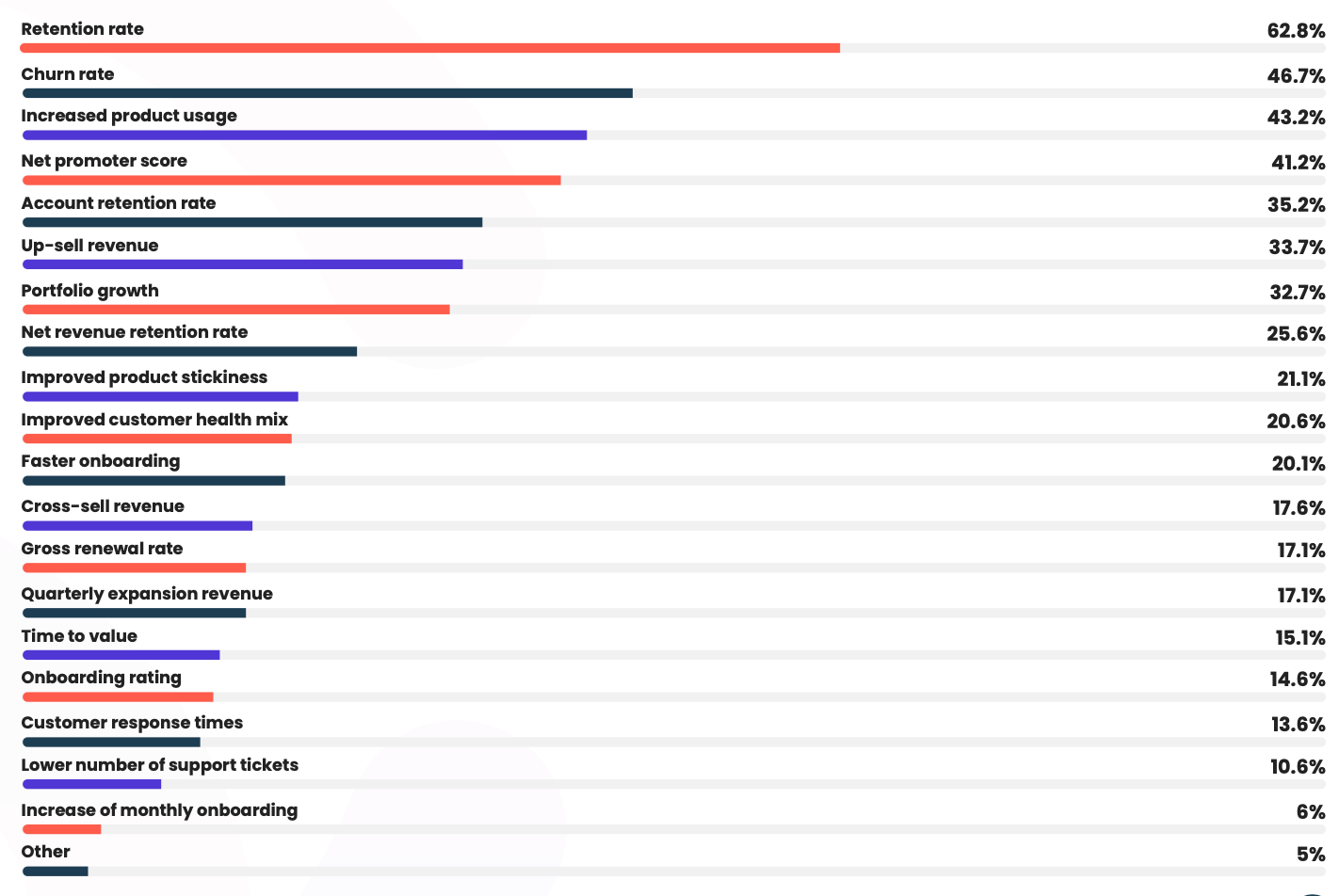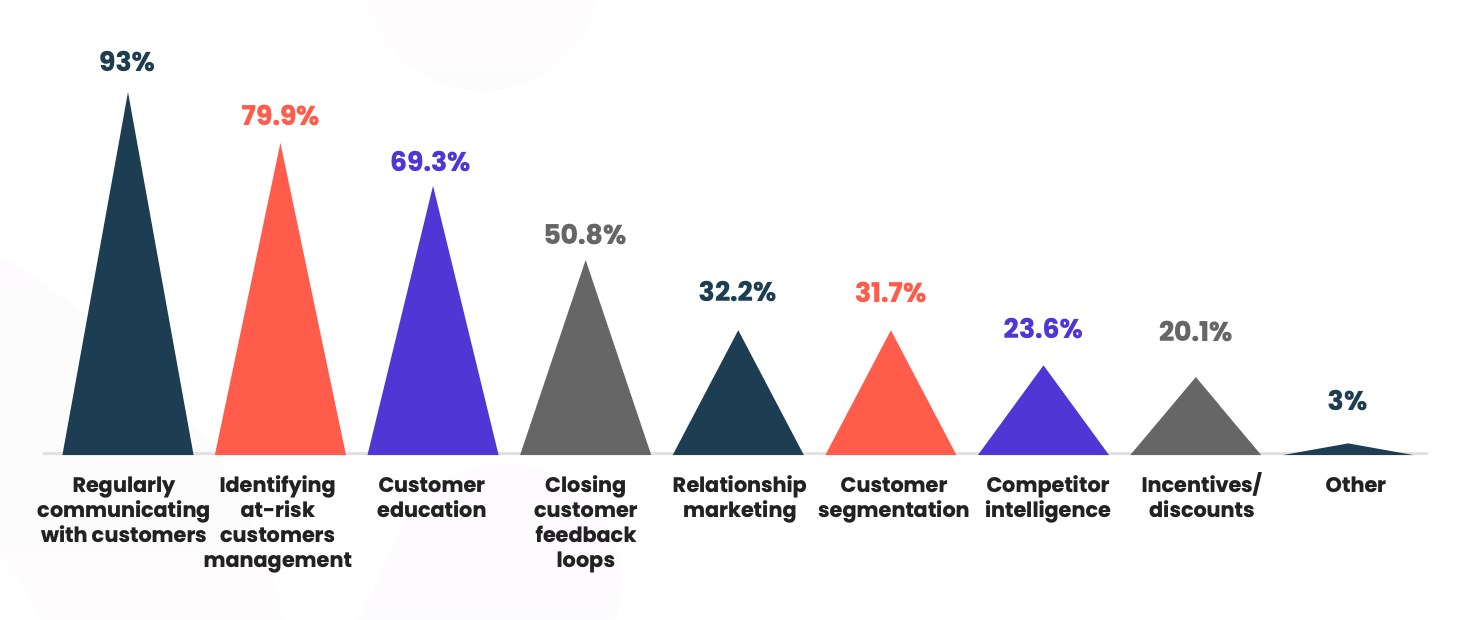Picture this: you have an in-demand product, a seemingly solid customer base, and money pouring in. Surely you’ve made it, right? But the thing is, none of these things matter without setting the right measures in place to monitor the good and the bad.
The motivation behind someone working in customer success is to help the customer achieve their goals, uniting the customer’s aspirations with the company. When creating this seamless, content relationship, the customer success function generates customer retention.
Every person who works in customer success will have different methods of managing their customer base, there isn’t a ‘one-size-fits-all’ answer for everyone. And without setting KPIs tailored to your business model, or if you fail to use customer success metrics, you can end up neglecting your business’ welfare and will probably lose customers to churn.
Let's take look into the world of KPIs, customer churn, and customer retention...

KPIs
The Oxford English Dictionary defines a key performance indicator (KPI) as ‘a quantifiable measure used to evaluate the success of an organization, employee, etc., in meeting objectives for performance.’
Having the appropriate KPIs in place can alert business owners on potential failings, allowing you to prevent poor situations from exacerbating. By definition, KPIs are a vehicle of proactivity, something undeniably analogous to customer success.
And if we’ve discovered anything, it’s that the experts who live and breathe customer success are a ridiculously proactive lot. We asked our customer success professionals what KPIs their own teams are measured on.
It turns out that only 62.8% of participants use retention rate as one of their own KPIs. Since customer retention is the lifeblood of customer success, we imagined that the CSMs or VPs of Customer Success would be held accountable for these pressing statistics. While this figure is by no means alarming, we expected more businesses to be using this critical metric as a KPI.
Nearly half of the survey respondents (46.7%) said that churn rate was a KPI they worked towards, with increased product usage (43.2%) and NPS (41.2%) being the most common answers. Surprisingly, it appears that the more mundane, day-to-day tasks required of customer success professionals don’t form the basis of their KPIs. For instance, reducing customer response times (13.6%) and lowering the number of support tickets (10.6%). This would suggest that this is a function of customer support, rather than under the remit of a customer success team.
Several respondents chose the option of ‘Other’ and divulged that KPIs are yet to be defined, suggesting that their CS teams are in their infancy.

Initially, we were surprised that less than half of CS practitioners use churn rate as a KPI, and put these unearthed findings to our interviewees, asking if they found this irregular:
‘No. Most now are using Net Retention Rate which is more telling about the overall health of a portfolio and includes churn as part of the calculation.’
- Maranda Dziekowski, Chief Customer Officer at Swiftly
‘It's not a surprise as CS is defined in so many ways. This includes KPIs. There is churn rate, renewal rate, net churn, net dollar retention rate. This is probably the reason for that data point being so low.’
- Chad Horenfeldt, Director of Customer Success at Kustomer
‘I think most companies view churn and retention as opposites, and that retention is just the more positive way of reporting it. However, the opposite of losing customers isn’t retaining customers, it’s gaining customers, which is ultimately the realms of sales. Retention is a more proactive measure; you are constantly working towards it. Whereas churn is reactive and focused just on the point of renewal. It’s for both of these reasons that retention is our ‘one metric that matters more so than churn.’
- Rebecca Fenlon, Head of Customer Success at Cognassist

Customer churn
If there’s one thing customer success aims to annihilate, it’s customer churn. Whether voluntary or involuntary, churn is something businesses want to stop and reduce immediately, so finding out how to measure it is an invaluable asset.
We asked our pool of customer success experts what their go-to tools are to measure churn. The responses we accrued were kaleidoscopic, with a mass of intriguing and diverse answers. The general consensus of our findings highlighted the following as the most common tools for measuring churn:
- Excel
- Gainsight
- ChurnZero
- HubSpot
- Salesforce
- Looker
There wasn’t a unanimous winner for churn-fighting tools, but this seems likely due to the different budgets of each customer success team and the individual company in question.
Trying to get ahead of customer churn is another thing entirely. There isn't a quick fix or universal solution to combat it, but the general consensus of our survey participants suggested that they endeavored to forecast renewals based on customer conversations, and their interactions with the product. Having regular communication with customers appeared to be the most effective way to anticipate churn, alongside business-wide monthly risk meetings.
Here’s what two of our survey respondents had to say:
"If the predicted churn is higher than average, we brainstorm about activities that will prevent users from churning. Although the data isn't always telling us the right thing, because a lot of people go to another license and that's still not visible in the data yet."
"We carefully watch which content the client is accessing (or not) and the frequency that they use the product. Those who are missing relevant content or not logging are at risk of causing churn. Additionally, competitors are trying to expand their share of the entity's budget."
In terms of counteracting customer churn, the results are more clear-cut
It’s widely accepted that proactivity is the definitive quality that separates customer success from customer support. Channeling that foresight into preventing churn is one of the driving forces behind CS.
Communication has always been the backbone of a strong customer success team, which is why it's unsurprising that 93% of our survey respondents regularly communicate with their customers to pre-empt churn.
Having these conversations provides valuable insight into the customer’s feelings about the product, to determine what is and what isn’t working for them.
79.9% of people pointed out that it’s necessary to identify at-risk customers to prevent churn. For whatever reason, these customers have a heightened potential to end their relationship with your business. This could be due to a number of different reasons i.e. low user engagement or negative feedback.

Minimizing the number of people becoming uninterested in your product sounds like a no-brainer, but pursuing it will drive a higher rate of engagement. The best way to do this? Education. Getting your customer base more familiar with how your product works is a shoo-in to nip churn in the bud. When we asked our survey participants, 69.3% agreed that customer education was an important factor in reducing churn.
Businesses can contribute to voluntary churn by not actioning customers’ queries – after all, no one likes being ignored. Half of the people we surveyed (50.8%) said that closing customer feedback loops were a tactic proven to stop customers churning of their own volition. Implementing relationship marketing strategies is something businesses can do to cultivate a more meaningful relationship with customers (32.3%), or perhaps dive into some competitor intelligence (23.6%). Fewer respondents suggested customer segmentation (31.7%), providing discounts to incentivize customers to stay (20.1%).
Taking these steps are proactive ways for businesses to avoid losing customers before it’s too late.
NB: 3% of our participants voted for ‘Other’ but didn’t specify a strategy.

To wrap up
Keeping an ear to the ground is a vital way to measure customer success, and the way to do it is clearly via metrics.
Monitoring customer churn and retention are the two pillars of any customer success team's KPIs, along with improving product adoption, with a low number of people focused on reducing customer response times (13.6%) and lowering the number of support tickets (10.6%).
We'd love to hear what you think about measuring customer success. If you have an opinion on KPIs, retention, churn, or maybe customer segmentation, feel free to drop us a message in our GTM Slack channel for a healthy debate.






